Common Dandelion Taraxacum officinale Uses, Research, Side Effects
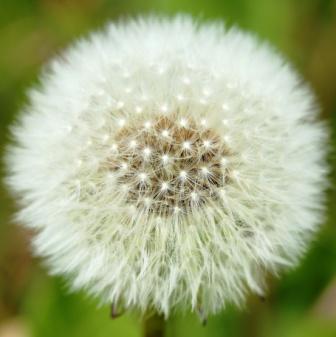
Common Dandelion Taraxacum officinale is a plant mentioned in Ayurveda for the treatment of skin diseases, fever, difficulty in micturition, indigestion, jaundice and general debility.
Latin name- Taraxacum officinale Weber ex Wiggers
Family- Asteraceae ( Bhringaraja kula)
Table of Contents
Vernacular names
Names in different languages:
Hindi name- Dudhali
English name- Common dandelion
Gujarati name- Pathradi
Marathi name- Batthur
Urdu name- Kaanful, Kaasani Dashti
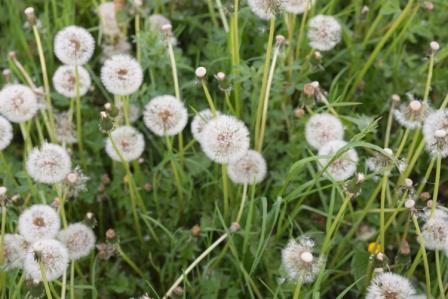
Sanskrit Synonyms
Payasvini, Lutari
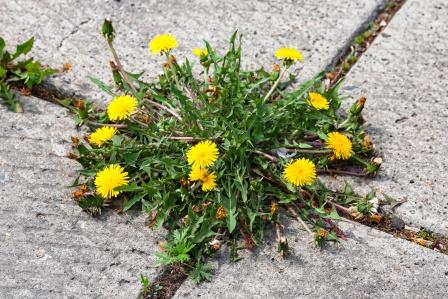
Morphology
Morphology of Common Dandelion:
Dugdhapheni is a small shrub which grows in the Himalayan belt till an altitude of 15000 feet. It can be found growing in temperate regions of the world, in lawns, on roadsides, on disturbed banks and shores of water ways, and other areas with moist soils. Taraxacum officinale grows from generally un-branched taproots and produces one to more than ten stems that are typically 5–40 cm (2.0 — 15.7 in) tall, but sometimes up to 70 cm (28 in) tall. The stems can be tinted purplish, they are upright or lax, and produce flower heads that are held as tall as or taller than the foliage. Plants have milky latex and the leaves are all basal. The yellow flower heads lack receptacle bracts and all the flowers are ligulate and bisexual. Dandelions are harvested from the wild or grown on a small scale as a leaf vegetable.
Classical categorization
Raja Nighantu- Parpatadi varga
Scientific classification
Kingdom: Plantae
Order: Asterales
Family: Asteraceae
Tribe: Cichorieae
Genus: Taraxacum
Species: T. officinale
Properties, part used, dosage
Properties:
Rasa (Taste) – Tikta (Bitter), Katu (Pungent)
Guna (Qualities) – Laghu (Light for digestion), Ruksha (Dry in nature), Teekshna (Hot)
Veerya (Potency) – Ushna (Hot)
Vipaka – Katu (Undergoes Pungent taste after digestion)
Karma (Actions) – Kaphapitta shamaka (reduces vitiated kapha and pitta dosha)
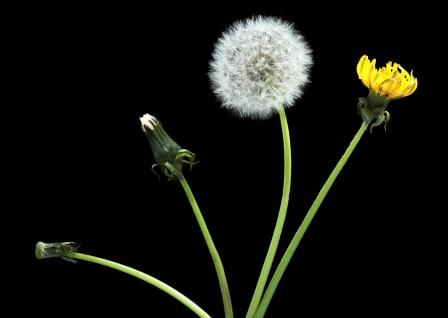
Part used- Root and Stem
Dosage-
Powder of root- 1 to 3 g
Decoction- 25 to 50 ml
Sanskrit verse
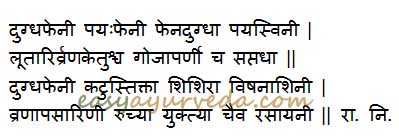
Chemical constituents
Chemical constituents of Taraxacum officinale:
The leaves of the plant contain sesquiterpene lactones, triterpenes and sterols. The whole plant contains eudesmanolides. Vitamin A content in the plant is higher than in carrots.
Uses, Adverse effects
Uses of Dugdhapheni:
- The decoction prepared from the plant Taraxacum officinale is given in a dose of 25-30 ml to treat jaundice and hepatitis.
- The fresh juice prepared from the leaves and root is given in a dose of 10-15 ml to treat fever and indigestion.
- The decoction prepared from the root of Dugdhapheni is given in a dose of 20-25 ml to treat intestinal worms and liver diseases.
- The paste of the leaf or root is prepared and applied over the area affected with skin diseases.
- The cold infusion prepared from Taraxacum officinale is given in a dose of 30-40 ml to treat burning micturition and difficulty in micturition.
- The decoction is given to treat general debility and poisonous cases due to insect bite.
- The stem is used as a vegetable in some parts of North India and other parts of the world.

Adverse effects: Patients suffering from renal diseases have to take precaution during the use of Dugdhapheni as the herb contains high amounts of potassium.
Ayurvedic formulations
Formulations containing Dugdhapheni:
Biolivac syrup and tablet: Biolivac Syrup & Tablet is a proprietary Ayurvedic medicine. It is a hepato-protective medicine used in the treatment of varieties of liver disorders.
Interaction with medicines, supplements
Can this be used while taking Homeopathic medicine?
Yes. This product does not react with homeopathic medicine.
Can this medicine be continued while taking supplements like multivitamin tablets, Omega 3 fatty acids etc?
Yes. Generally, this product goes well with most dietary supplements. However, if you are taking more than one product per day, please consult your doctor for an opinion.
With western
medicines
Seek your
doctor’s advice if you are taking this product along with other western
(allopathic / modern) medicines. Some Ayurvedic herbs can interact with modern
medicine.
If both Ayurvedic and allopathic medicines are advised together, then it is
best to take Allopathic medicine first, wait for 30 minutes and then take the
Ayurvedic medicine.
Research
Research articles about Taraxacum officinale:
Anti- inflammatory action: This study aims to ascertain the anti-inflammatory effect of the Taraxacum officinale ethanolic leaf extract (TOLE) on pulmonary vascular permeability and H1-receptors in the ileum of ovalbumin (OA)-sensitized guinea-pigs. The results showed a significant dose-dependent reduction in anti-histaminic activity (p < 0.05) on isolated guinea-pig ileum. Histopathological lesions such as perivascular oedema, hypertrophy of smooth muscles, infiltration of eosinophils and basophils were reduced in the lungs of TOLE treated group compared to OA-sensitized controls.
Variants of dandelion
Dandelion greens, raw
Taste – sweet, bitter
Properties – heavy (high in nutrients), dry (reduces cholesterol)
Potency – hot (promotes healthy digestion)
After digestion taste transformation ( Vipaka ) – sweet
Effect on Doshas
Vata balancing (helps to treat constipation)
Pitta nourishing (promotes healthy digestion)
Kapha nourishing (boosts immune system)
Dandelion greens, cooked, boiled, drained, without salt
Taste – sweet, bitter
Properties – not very heavy (as it is cooked, drained), dry (reduces cholesterol)
Potency – hot (promotes healthy digestion)
After digestion taste transformation ( Vipaka ) – sweet
Effect on Doshas
Vata balancing (helps to treat constipation)
Pitta nourishing (promotes healthy digestion)
Kapha neutral (it does not nourish Kapha as it is cooked and drained, where most nutrients are lost)
Dandelion greens, cooked, boiled, drained, with salt
Taste – sweet, bitter, slightly salty
Properties – not very heavy (as it is cooked, drained), dry (reduces cholesterol)
Potency – hot (promotes healthy digestion)
After digestion taste transformation ( Vipaka ) – sweet
Effect on Doshas
Vata balancing (helps to treat constipation)
Pitta nourishing (promotes healthy digestion, salt is also Pittakara)
Kapha neutral (it does not nourish Kapha as it is cooked and drained, where most nutrients are lost)
Author: Dr.B.K.Prashanth M.D (Ayu), Ph.D
E mail: drprashanthbk@gmail.com
Systemic action
External use – Cleanses the wounds. Juice is used for chronic wound cleansing
Digestive System – Carminative, Purgative, Anti helminthic, Pittasaraka (Helps for the release of bile/ digestive enzymes), Indicated in loss of appetite, Jaundice, Constipation, Ascites and in Helminthiasis.
Circulatory system – Blood purifier and indicated in Edema
Excretory system – Increases urine production, indicated in dysuria
Skin – Sevda janana
Tapakrama – Indicated in Fever (jirnajvara)
Satmikarana – Ant poisonous, indicated in general weakness








